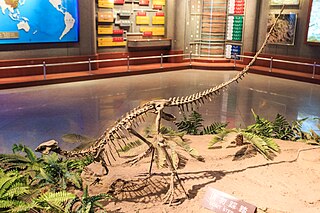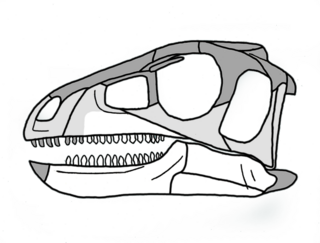Related Research Articles

Dinosaurs are a diverse group of reptiles of the clade Dinosauria. They first appeared during the Triassic period, between 243 and 233.23 million years ago (mya), although the exact origin and timing of the evolution of dinosaurs is a subject of active research. They became the dominant terrestrial vertebrates after the Triassic–Jurassic extinction event 201.3 mya and their dominance continued throughout the Jurassic and Cretaceous periods. The fossil record shows that birds are feathered dinosaurs, having evolved from earlier theropods during the Late Jurassic epoch, and are the only dinosaur lineage known to have survived the Cretaceous–Paleogene extinction event approximately 66 mya. Dinosaurs can therefore be divided into avian dinosaurs—birds—and the extinct non-avian dinosaurs, which are all dinosaurs other than birds.

A tetrapod is any four-limbed vertebrate animal of the superclass Tetrapoda. Tetrapods include all extant and extinct amphibians and amniotes, with the latter in turn evolving into two major clades, the sauropsids and synapsids. Some tetrapods such as snakes, legless lizards, and caecilians had evolved to become limbless via mutations of the Hox gene, although some do still have a pair of vestigial spurs that are remnants of the hindlimbs.

Richard Alan Fortey is a British palaeontologist, natural historian, writer and television presenter, who served as president of the Geological Society of London for its bicentennial year of 2007.

Agilisaurus is a genus of ornithischian dinosaur from the Middle Jurassic Period of what is now eastern Asia. It was about 3.5–4 ft long, 2 ft in height and 40 kg in weight.

Echinodon is a genus of heterodontosaurid dinosaur that lived during the earliest Cretaceous of southern England and possibly western France in the Berriasian epoch. The first specimens were jaw bones named Echinodon becklesii by Sir Richard Owen in 1861, and since their original description only additional teeth have been discovered. The specific name honours collector Samuel Beckles who discovered the material of Echinodon and many other taxa from across England, while the genus name translates as "prickly tooth" in reference to the dental anatomy of the taxon.

Michael James Benton is a British palaeontologist, and professor of vertebrate palaeontology in the School of Earth Sciences at the University of Bristol. His published work has mostly concentrated on the evolution of Triassic reptiles but he has also worked on extinction events and faunal changes in the fossil record.

Darren William Naish is a British vertebrate palaeontologist, author and science communicator.

Pisanosaurus is an extinct genus of early dinosauriform, likely an ornithischian or silesaurid, from the Late Triassic of Argentina. It was a small, lightly built, ground-dwelling herbivore, that could grow up to an estimated 1 m (3.3 ft) long. Only one species, the type, Pisanosaurus mertii, is known, based on a single partial skeleton discovered in the Ischigualasto Formation of the Ischigualasto-Villa Unión Basin in northwestern Argentina. This part of the formation has been dated to the late Carnian, approximately 229 million years ago.

Paleobiology is an interdisciplinary field that combines the methods and findings found in both the earth sciences and the life sciences. Paleobiology is not to be confused with geobiology, which focuses more on the interactions between the biosphere and the physical Earth.

Heterodontosauridae is a family of ornithischian dinosaurs that were likely among the most basal (primitive) members of the group. Their phylogenetic placement is uncertain but they are most commonly found to be primitive, outside of the group Genasauria. Although their fossils are relatively rare and their group small in numbers, they have been found on all continents except Australia and Antarctica, with a range spanning the Early Jurassic to the Early Cretaceous.

Zofia Kielan-Jaworowska was a Polish paleobiologist. In the mid-1960s, she led a series of Polish-Mongolian paleontological expeditions to the Gobi Desert. She was the first woman to serve on the executive committee of the International Union of Geological Sciences. The most notable dinosaur species she discovered include: Deinocheirus and Gallimimus while Kielanodon and Zofiabaatar were named in her honour.

Philip Conrad James Donoghue FRS is a British palaeontologist and Professor of Palaeobiology at the University of Bristol.
M. Paul Smith is a British palaeontologist, head of the Oxford University Museum of Natural History and professor in Kellogg College. Previously he was Professor of Palaeobiology at the University of Birmingham, head of the university's School of Geography, Earth and Environmental Sciences, and Director of its Lapworth Museum of Geology. He received his BSc from the University of Leicester and his PhD from the University of Nottingham.
William Alvin Clemens Jr. was a paleontologist at the University of California at Berkeley. He was faculty of the Department of Paleontology from 1967, then the Department of Integrative Biology from 1994 to his retirement and curator of the UC Museum of Paleontology. Clemens was also director of the museum (1987–1989) and chair of the Department of Paleontology (1987–1989). He was awarded a Guggenheim Fellowship (1974–75), a U.S. Senior Scientist Award by the Alexander von Humboldt Foundation, the Romer-Simpson Medal (2006), and was made a Fellow of the California Academy of Sciences.
Christian Alfred Sidor is an American vertebrate paleontologist. He is currently a Professor in the Department of Biology, University of Washington in Seattle, as well as Curator of Vertebrate Paleontology and Associate Director for Research and Collections at the Burke Museum of Natural History and Culture. His research focuses on Permian and Triassic tetrapod evolution, especially on therapsids.
Martín Dário Ezcurra is an Argentine palaeontologist naming many extinct genera such as Aerotitan, Lophostropheus and Powellvenator.

Susannah "Susie" Catherine Rose Maidment is a British palaeontologist at the Natural History Museum, London. She is internationally recognised for her research on ornithischian dinosaur evolution, and was awarded the 2016 Hodson Award of the Palaeontological Association and the 2017 Lyell Fund of the Geological Society of London. She was featured as a 2019 National Geographic Women of Impact.
Varavudh Suteethorn, or Warawut Suteethorn is a Thai palaeontologist and geologist. He is the current director of the Palaeontological Research and Education Centre, Mahasarakham University. He is best known for his work on vertebrate paleontology in northeastern Thailand, having contributed to the discovery of many fossil taxa and dig sites in the Khorat Plateau, as a part of a long-standing collaboration between Thai and French scientists.

Lauren Sallan is an American academic who is the head of the Macroevolution Unit at the Okinawa Institute of Science and Technology and was previously the Martin Meyerson Assistant Professor in Interdisciplinary Studies at the University of Pennsylvania. She is a paleobiologist who uses big data analytics to study macroevolution. She is a TED Senior Fellow and has two TED talks with almost three million views as of 2022.
The evolution of fishes took place over a timeline which spans the Cambrian to the Cenozoic, including during that time in particular the Devonian, which has been dubbed the "age of fishes" for the many changes during that period.
References
- 1 2 3 4 5 6 "Professor Richard Butler – School of Geography, Earth and Environmental Sciences – University of Birmingham". www.birmingham.ac.uk. Retrieved 2019-05-04.
- ↑ "Richard J Butler". Google Scholar. Retrieved November 6, 2019.
- ↑ "Medal and Award Winners List | The Palaeontological Association". www.palass.org. Retrieved 2023-12-21.